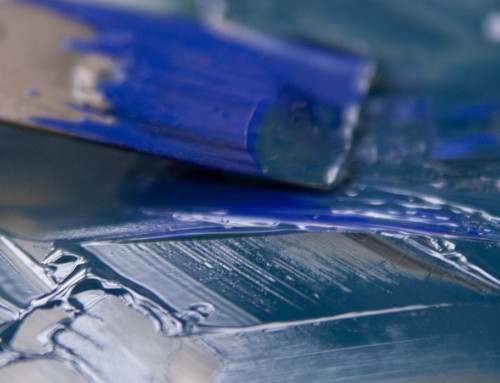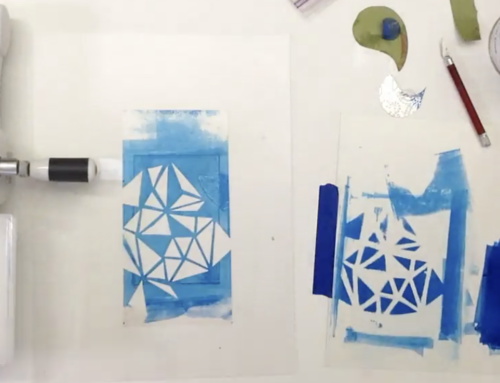A pdf of the Monotype: Overview and the Monotype: Getting Started text can be downloaded here.
If you are reading on a mobile device, click here to open the google slide presentation.
Overview
Monotypes are unique, painterly prints. Pigment is applied by drawing or painting on a smooth, unabsorbent matrix, or printing plate, such as a plastic or metal plate. The pigmented marks are transferred to a substrate, such as paper, by pressing the matrix and substrate together using even pressure, usually by running the stack through a printing press. The image is created backwards as it will flip when printed.
Monoprints use a matrix that contains repeatable information, such as a drypoint or collagraph plate. Hand applied ink creates variation of mark and color that is integrated with the reproducable imagery.
The marks created by monotype printing are unique, with qualities that can only be created using this printmaking method. The first print from the plate will transfer most of the pigment, resulting in a vibrant image. The residual ink from the plate can be printed to create a ghost print, or lighter impression, or further manipulated for subsequent prints. Chance, irregularity, and randomness transform the mark of the artist’s hand, resulting in a collaboration between the monotype process and the artist.
History
A recent publication by Joseph Viscomi, William Blake’s Printed Paintings: Methods, Origins, Meanings, beautifully presents the development of monotype and monoprint. Below is a summary of key historical artists and dates.
In the late 1500s, three painters and experimental printmakers independently created monotypes; Hercules Sughers (1589-1638), Antoon Sallaert (1594-1650) and Benedetto Castiglione (1609-1664). The artists experimented with additive approaches, applying ink directly to the smooth printing plate, and subtractive approaches, where a film of rolled ink is selectively removed from the plate with various tools. Around the same time, Rembrandt van Rijn (1606-1669) explored painterly prints, selectively inking and wiping his etching plates to produce unique monoprints.
William Blake (1757-1827), unaware of his predecessors, rediscovered the approach and created unique multiples, or printed paintings. In 1794 and 1795 Blake developed a relief etching technique, hand applying colors to the printing plate, then transferring the ink to paper using a rolling pin and light pressure.
In the late 1800s Edgar Degas (1834-1917) produced an extensive series of monotype prints, employing the direct, fluid monotype marks as he captured bodies in motion. Other impressionist and surrealist painters continued the explorations, including Pissaro, Gauguin, Picasso, Chagall, Maurice Prendergast, Rouault and Max Ernst.
As printmaking studios burgeoned in the mid-1900s, and University printmaking programs became established, monotype and monoprint grew in application and recognition. Today, many artists employ these approaches in their work. Below is a slide show of contemporary examples. Click on the artist’s name to learn more.

